Understanding Reiner Knizia, board gaming's most prolific designer
I'm diving deep into the data.
Every now and then, I stumble across a desire to really dive unnecessarily deep into a topic, hoping somehow to come out the other side with a better understanding of a topic.
That happened to me last week when I was reading Bluesky, and Efka of No Pun Included posted a small bit about Reiner Knizia. Nothing outlandish, nothing unusual, but the replies sent me down a path, this one in particular.
That seems true, I thought. I wanted to really figure it out, though. I knew the data was out there — what could I learn from it? Board Game Geek is a treasure trove; how could it help me? Could I harness their API to gather enough data to learn something interesting? It turns out that the answer is yes, and you may have gathered that by my writing a post about it in the first place.
What follows is an exploration into that data. Everyone knows Reiner Knizia is a prolific designer, but how prolific is he, really?
First, let’s start at the baseline. Dr. Knizia has published 787 games across five decades, with his first design coming all the way back in 1980 with Desperados, a partnership card game. It was most recently republished in 2011. His output has proven prolific even recently, with a chart-topping 40 games published in 2024. He’s already up to 36 in 2025, meaning this year could be his most prolific yet.
What does being prolific entail, though? How much of his 787-game catalog can be called an ‘original’ design? What does the data tell us?
To start, let’s look at 2024. Given it’s a complete year, this gives us a better look at his output than looking at a year with incomplete releases. It won’t be perfect, but it’ll be something meaningful. An initial look at games released in 2024 shows a staggering 40 games, but how many of those were original designs? We’ll define an original design here as one that is not a reimplementation of an existing game and is not an expansion. It’s not perfect, as there will likely be some games marked as reimplementations on BGG that are importantly different, and there will likely be some not marked that are. It’s a known flaw, and I’ll hope that it balances out in the end.
For 2024, how many of Knizia’s 40 published titles were original? A revised look shows 18 original designs, 16 reimplementations, and 6 expansions. Overall, we’re looking at 522 games. Now, this again doesn’t capture everything — does each ‘Pick a Pen’ game warrant the mark of ‘original design’? Perhaps not, so if a game is part of a series, we’ll also do some filtering here, and they’ll count as ‘reimplementations’. We’re now down to 17 original designs in 2024, and we’re at 503 overall, and that just seems much more reasonable.
And I was going to stop there, but I remembered one more thing: Knizia has published a lot of games in magazines, which Efka calls out in a reply to his post I linked above. Filtering those out doesn’t move the needle greatly, but we are now down to 475 games total. Remove games published as books, too, and we’re down to roughly 438. We could keep whittling down, but I think we’re getting closer to a true number.
Of course, this is an absolutely staggering figure all the same. Some great games, like Carcassonne: The Castle (2003) are marked as reimplementations, and while that’s certainly true in a sense, it doesn’t rule the game out from being one of my favorite spins on the classic tile-layer. Some of his reimplementations of his own designs, too, have proven sometimes more successful than the games they reimplement: Zoo Vadis (2023) has significantly more acclaim than his 1992 take on negotiation games, Quo Vadis? — some of that may be the passage of time, some of it may be that anthropomorphic animals have a broader appeal than the Roman Senate.
While we should acknowledge here a certain weakness in the data, we can also say with some certainty that with 787 credited designs, some funny data is to be expected. Of course, the data itself cannot examine the intricacies of his game design, and it won’t tell us which auction games use the same mechanics in slightly different ways. That’s a task a bit too far from feasibility in this little newsletter, though I suspect I could write a well-considered thesis on the topic.
Reiner Knizia is an interesting game designer. He’s always putting out some new release — maybe it’s only coming out in Japan, maybe it’s landing in Poland, or maybe it’ll stay put in Germany. U.S.-based publishers like the dentist-run Bitewing Games have premiered reimplementations and new designs from Knizia. There remains demand for new games, despite the immense volume. His name is one of the first I recognized while starting my board game journey.
It’s a curiosity, then, that he’s only won the Spiel des Jahres prize once. You’d think with that sort of volume, the odds would increase, but Keltis (2008) — later (but not much later!) reimplemented as Lost Cities: The Board Game (also 2008) — remains his own selection for the prize. It’s perhaps good that he’s not been too greedy about that, I suppose.
To wrap up this portion, I’d like to just take a walk through some of the facts I’ve learned about Dr. Knizia’s designs:
None of his games are currently in the top 100 on BoardGameGeek. I’m not sure why. His closest is #122, The Quest for El Dorado (2017).
Only one of his designs are listed as taking more than 120 minutes, and that’s Hollywood Lives (2004), which looks to be a party game in the style of a murder mystery. It’s a co-designed game with Kevin Jacklin.
One of Knizia’s most enduring designs, Tigris & Euphrates (1997), sits at a 120-minute playtime.
Of his 787 designs, only 28 were co-designed. My favorite? Carcassonne: The Castle, with Klaus-Jürgen Wrede.
He’s designed 15 games and expansions that feature J.R.R. Tolkien’s Lord of the Rings and The Hobbit, including the early cooperative board game Lord of the Rings (2000).
His top category on BGG is “Card Game,” with 34% of his designs having that feature. 22% of his designs are games aimed at children.
His most re-implemented game is Keltis, which was reimplemented six times. Ingenious (2004) and Schotten Totten (1999) both have five reimplementations, and L.L.A.M.A. (2019) and Ra (1999) both have four.
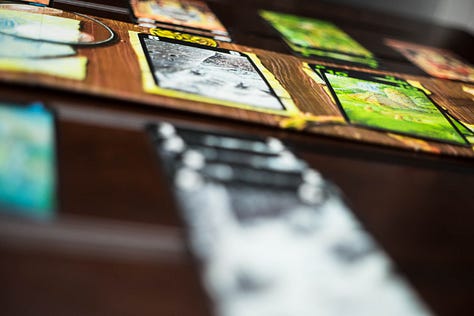
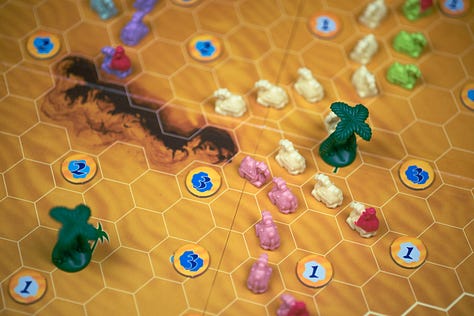
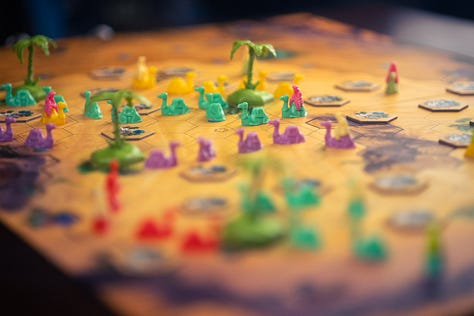
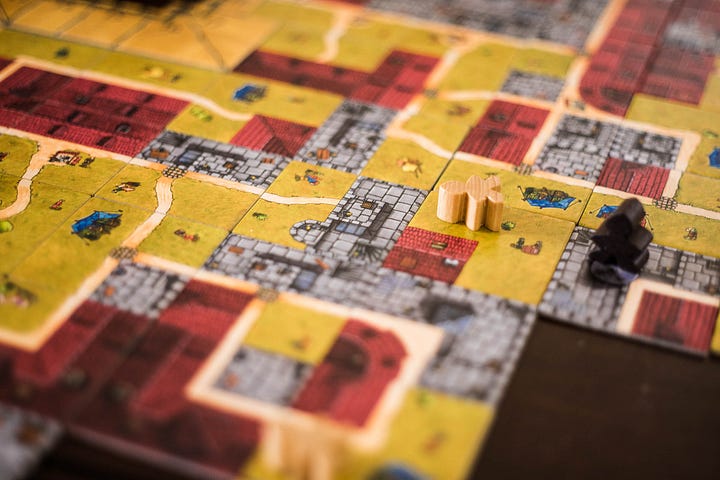
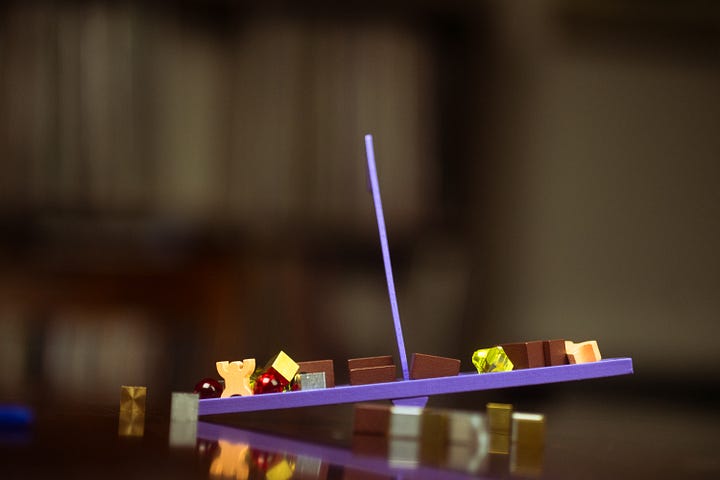
I thought I’d end this little thing by talking about a few of my favorite games from the good doctor in brief.
Lost Cities (1999) is a little bit of a push-your-luck two-player game in which you’re going on an expedition searching for treasure.
Modern Art (1992) is one of the classic Knizia auction games, with several kinds of auctions taking place each round
Through the Desert (2005) is a great route-building game where you’re blocking off other player’s routes with pastel camels
Carcassonne: The Castle (2003) is a spin on the classic, but it’s considerably more constrained, as you must build within the castle walls — and you can place meeples on the walls, which is a nice twist
Viking See-Saw (2021) has players placing treasure on a ship that tilts from end to end, and if you’re the one to make it tilt, you have to take more treasure to later place on the ship
And if those don’t tickle your fancy, there are 783 others for you to take a gander at — the world is your oyster.
Well, that was a bit of a whirlwind, and I spent a lot more time on the data than I did on the post. If you’re interested in making use of the data I’ve put together, so if you want to play with it yourself, just let me know, and I’ll send it your way.
In personal news, today’s my son’s second birthday, and we have a couple games I’m excited to start introducing him to. If you’ve got any recommendations for toddlers, do let me know.
I hope you’re all well — we’ll talk next week!





Thanks for the dive into the data, often wondered about that number!
Now - Toddler games!
Little Astronauts has been a hit with my 2 and 4 year olds - not really any meaningful decisions to make but feels like a good intro to playing games and you learn about the planets in the solar system and numbers as you go.
More challenging for the littler one but My First Carassonne is my most played game with the kids and probably my own favourite of the bunch - all moves are legal but some moves are better than others; so some room for developing a bit of strategic thinking. Sometimes they just do a move to help the other one out and it's very sweet.
And turns out Animal upon Animal is as good as everyone says it is.
https://boardgamegeek.com/boardgame/365656/little-astronauts
https://boardgamegeek.com/boardgame/41010/my-first-carcassonne
https://boardgamegeek.com/boardgame/17329/animal-upon-animal
Super interesting! I just wonder how he gets so many out in such a small time. Very surprised about him not being in the bgg top 100.